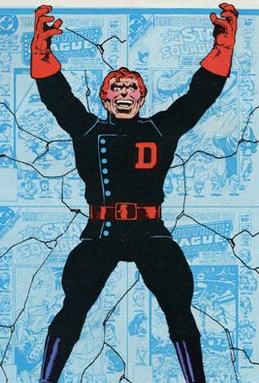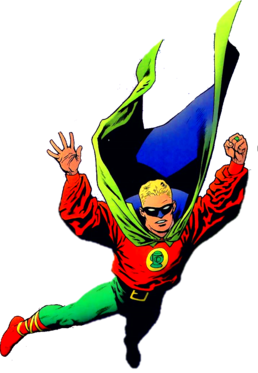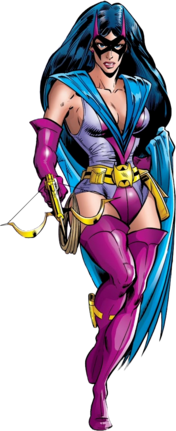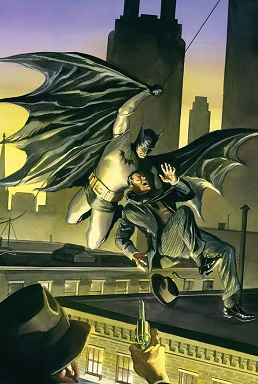
The Justice Society of America (JSA) is a superhero team appearing in American comic books published by DC Comics. It was conceived by editor Sheldon Mayer and writer Gardner Fox during the Golden Age of Comic Books. It first appeared in All Star Comics #3, making it the first team of superheroes in comic books. Its original members were Doctor Fate, Hourman, the Spectre, Sandman, Atom, the Flash, Green Lantern and Hawkman.

The All-Star Squadron is a DC Comics superhero team that debuted in Justice League of America #193 and was created by Roy Thomas, Rich Buckler and Jerry Ordway. Although the team was introduced in the 1980s, its self-titled series took place in the 1940s, retroactively inserting their narratives into the fictional history of the DC Comics superheroes. The team included many of DC's Golden Age era characters, new characters, and other World War II superheroes that DC did not own during the 1940s but later acquired. The name "All-Star Squadron" was creator Roy Thomas' reference to All Star Comics, the series that introduced the Justice Society of America, the first comic book superhero team.
Power Girl, also known as Kara Zor-L, and Karen Starr, is a superheroine appearing in American comic books by DC Comics, making her first appearance in All Star Comics #58. Power Girl is the cousin of the superhero Superman, but from an alternate universe in the fictional multiverse in which DC Comics stories are set. Originally hailing from the world of Earth-Two, first envisioned as the home of DC's wartime heroes as published in 1940s comic books, Power Girl becomes stranded in the main universe where DC stories are set, and becomes acquainted with that world's Superman and her own counterpart, Supergirl.
The Injustice Society is a group of supervillains in the DC Comics Universe. They are the main antagonists of the Justice Society of America.

Johnny Thunder is the name of three superheroes appearing in comics published by DC Comics. A fourth character has the variant name Jonni Thunder.

Wildcat is a fictional superheroine in DC Comics' shared universe, the DC universe. Her first appearance was in Infinity Inc. #12 and she was created by Roy Thomas, Dannette Thomas and Don Newton.

Jason Peter "Jay" Garrick is a superhero appearing in American comic books published by DC Comics. He is the first character known as the Flash. The character first appeared in Flash Comics #1, created by writer Gardner Fox and artist Harry Lampert.
Earth-One is a name given to two fictional universes that have appeared in American comic book stories published by DC Comics. The first Earth-One was given its name in Justice League of America #21, after The Flash #123 explained how Golden Age (Earth-Two) versions of characters such as the Flash could appear in stories with their Silver Age counterparts. This Earth-One continuity included the DC Silver Age heroes, including the Justice League of America.

Detective Chimp is a superhero appearing in American comic books published by DC Comics. A common chimpanzee who wears a deerstalker hat, Detective Chimp has superhuman-level intelligence and solves crimes, often with the help of the Bureau of Amplified Animals, a group of intelligent animals that also includes Rex the Wonder Dog. He was originally created in the final years of the Golden Age of Comic Books, continuing into the early years of the Silver Age.

Gentleman Ghost, introduced as Ghost, and also known as Gentleman Jim, is a supervillain appearing in works published by DC Entertainment. Created by writer Robert Kanigher and artist Joe Kubert, the character first appeared in Flash Comics #88.

The Wizard is a supervillain appearing in American comic books published by DC Comics.

Icicle is the name of two supervillains appearing in comic books published by DC Comics: Joar Mahkent and Cameron Mahkent.

Per Degaton is a supervillain appearing in American comic books published by DC Comics. He is a known time-traveling villain who is a recurring enemy of the Justice Society of America.

Alan Wellington Scott is a superhero appearing in American comic books published by DC Comics, and the first character to bear the name Green Lantern. He fights evil with the aid of his mystical ring, which grants him a variety of powers. He was created by Martin Nodell and Bill Finger, first appearing in the comic book All-American Comics #16, published on July 10, 1940.

The Huntress, also known as Helena Wayne, is a superheroine appearing in American comic books published by DC Comics. The character is the daughter of the Batman and Catwoman of an alternate universe established in the early 1960s and referred to as "Earth-Two", where the Golden Age stories took place. A modern-day predecessor of Helena Wayne as Huntress with no blood-relation to Batman or Catwoman, Helena Bertinelli, was additionally co-created by the character's co-creator Joe Staton in 1989, originally intended as a reinvention of the character following the events of Crisis on Infinite Earths, before being retconned as different characters.

Johnny Quick is a Golden Age DC Comics character with the power of superhuman speed. The character first appeared in More Fun Comics #71. After his More Fun run ended in issue #107, he was moved to Adventure Comics with issue #103. He remained as a regular feature in Adventure until issue #207.

The Batman of Earth-Two is an alternate version of the superhero Batman, who appears in American comic books published by DC Comics. The character was introduced after DC Comics created Earth-Two, a parallel world that was retroactively established as the home of characters whose adventures had been published in the Golden Age of comic books. This provided justification within the fictional world of Batman stories for DC Comics publishing Batman comic books that disregarded the character's Golden Age stories, as Batman had been presented as a single ongoing incarnation of the character since his earliest stories were published.

Robin of Earth-Two is an alternate version of the superhero Robin, who appears in American comic books published by DC Comics. The character was introduced after DC Comics created Earth-Two, a parallel world that was retroactively established as the home of characters which had been published in the Golden Age of comic books. This allowed creators to publish comic books taking place in current continuity while being able to disregard Golden Age stories featuring Robin, solving an incongruity, as Robin had been published as a single ongoing incarnation since inception. Unlike his main counterpart, Robin is the only alter ego of Dick Grayson, who uses the title into adulthood, rather than taking on later codenames such as Nightwing or Batman. In addition, the name "Robin" is not taken on by later characters.

"The Lightning Saga" is a comic book crossover story arc that took place in DC Comics' two flagship team books: Justice League of America and Justice Society of America. It was written by Brad Meltzer and Geoff Johns, and illustrated by Ed Benes, Dale Eaglesham, and Shane Davis. It is notable for re-introducing the Legion of Super-Heroes in the post-Infinite Crisis era.

The Huntress is the name of several fictional characters appearing in American comic books published by DC Comics, commonly in association with the superhero Batman. The two best-known women to bear the Huntress name are Helena Bertinelli and Helena Wayne, the latter being from an alternate universe. Although Helena Wayne and Helena Bertinelli are both superheroes, the Huntress of the Golden Age was a supervillain.

















